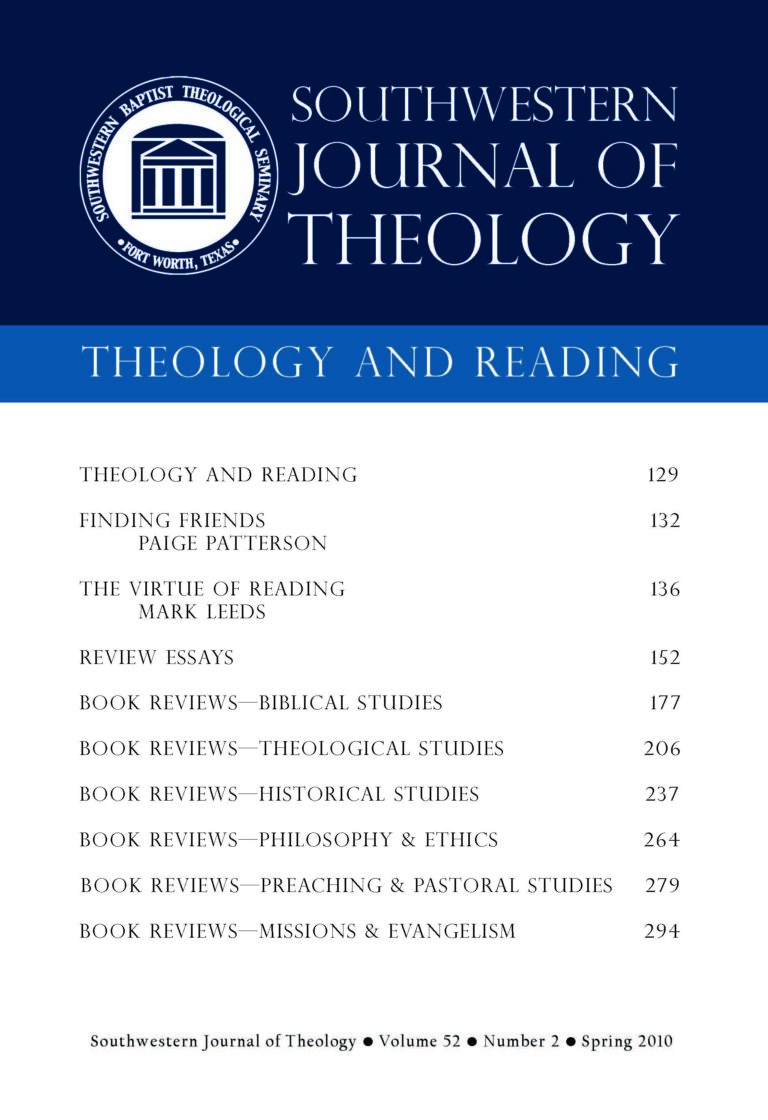
Theology and Reading
Southwestern Journal of Theology
Volume 52, No. 2 – Spring 2010
Managing Editor: Malcolm B. Yarnell III
Edited By Craig A. Evans and Emanuel Tov. Acadia Studies in Bible and Theology. Grand Rapids: Baker, 2008. 272 pages. $15.00.
With growing interest in all things canon-related in biblical studies, Craig A. Evans and Emanuel Tov have edited a volume devoted to some fundamental issues related to the Bible’s development and content. Evans, Distinguished Professor of New Testament at Acadia Divinity College, has added another meaningful work to his already impressive resume of over thirty publications. Tov, Professor of Bible at Hebrew University in Jerusalem, and an icon of Old Testament textual criticism, likewise continues to make significant contributions to biblical studies discussions.
Exploring the Origins of the Bible consists of essays by eight authors who presented their contributions at the Spring 2006 Hayward Lectures at Acadia Divinity College. In addition to essays by Evans and Tov, respectively dealing with the portrait of Jesus in non-canonical Gospels and the importance of the Septuagint for interpretation, the book includes essays devoted to investigating the perception of extra-biblical literature during the time of Jesus ( James Charlesworth), how the Hebrew Bible developed into its three-part structure (Stephen Dempster), the factor of the Septuagint in the shaping of canon traditions (R. Glenn Wooden), the development and canonization of the biblical Pauline corpus (Stanley Porter), the heterogeneous nature of early Christian perspectives on the New Testament canon (Lee Martin MacDonald), and a concluding essay on the theological implications of canon study ( Jonathan Wilson).
Among the strengths of the book is the diversity of perspectives that the authors bring. For example, Charlesworth argues that there was no concept of a canon of Scripture during the time of Jesus, arguing, instead, that many works now considered to be extra-biblical were believed to be equally sacred to books which—according to him—were later incorporated into a canon. Dempster, on the other hand—not specifically responding to Charlesworth—argues that Torah, Prophecy, and Wisdom were viewed as uniquely authoritative in early Judaism. This difference in perspective, within the volume itself, exposes the different approaches to canon formation, and provides a glimpse of the nature of the canon debate along with the presuppositions at play therein.
Another strength of the book is the attention it gives to the importance of the Septuagint (LXX). The essay by Wooden demonstrates the complexity that the New Testament’s appeal to the LXX as authoritative Scripture introduces into discussions regarding biblical inspiration. He appeals to the New Testament’s use of the LXX as evidence that the church has not historically—at least in practice— equated inspiration with the original text of Scripture, but with “the text received and used in the church at various times and in various languages” (144). Even if one disagrees with Wooden’s conclusions regarding the often-assumed priority of the Hebrew, Aramaic, and Greek texts of the Bible over their translations, he must carefully consider his argument in light of the New Testament’s use of the LXX.
Tov, in concert with Wooden’s appraisal of the importance of the LXX, demonstrates why the LXX cannot be ignored when interpreting the Old Testament. His essay focuses on instances in the Hebrew Bible where variations between the LXX and the Masoretic text (MT) significantly alter one’s reading of biblical books. Tov argues, furthermore, that many of the discrepancies between the MT and the LXX arise from the existence of a separate, early text type that served as a Vorlage to the LXX. Tov’s essay shows that one cannot simply dismiss Septuagintal text variants as late corruptions of the text represented by the MT. Study of the Hebrew Bible should, therefore, give consideration to both the LXX and the MT.
One significant omission from the book’s contents is a chapter that focuses on the role of the Jewish community and the church in canon formation. Without suggesting that these communities imposed sacred, authoritative significance on biblical texts, one cannot ignore the role of the believing community in the development and finalization of the biblical canon. The faith community’s role in canon formation does come up at times within various essays in the book, but only secondarily, as it pertains to the topic at hand. Certainly, however, an entire chapter could be devoted to this issue alone, even if it was included as a supplement to the papers delivered at the Hayward Lectures. It is hard to explore biblical origins adequately without giving any attention to this matter.
Exploring the Origins of the Bible, nonetheless, provides helpful insight into discussions revolving around the biblical canon. It introduces fresh information, challenges assumptions, and defends the importance of its subject matter, having implications for history, hermeneutics, textual criticism, and theology. The book, however, is not an introductory work; it assumes previous exposure to the issues it discusses. It is nonetheless a must read for those doing serious biblical or theological study within the academy.





